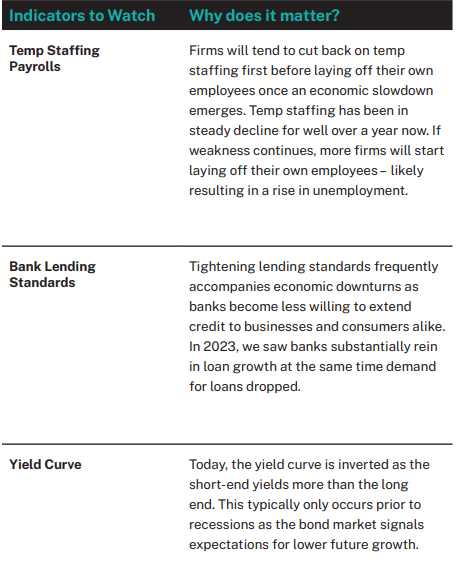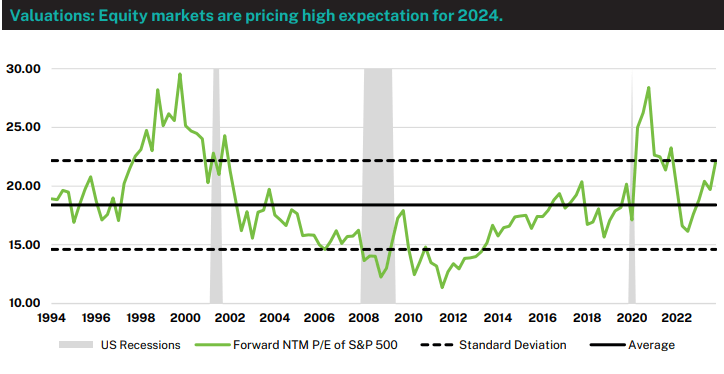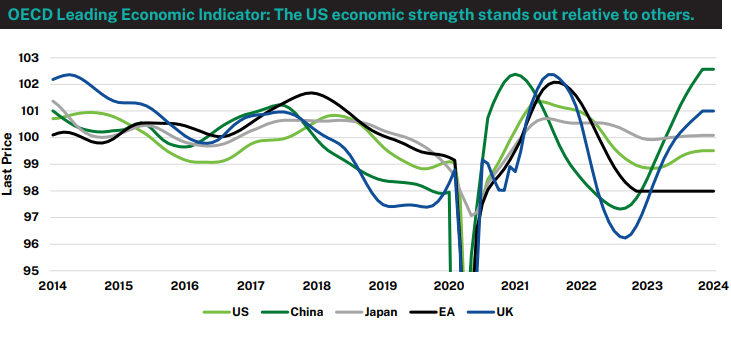Soft landing: <noun> – a rare economic phenomenon of a central bank able to bring inflation under control via higher interest rates without creating a recession.
Dictionary publisher, Merriam Webster, recently announced that “authentic” was selected as the word of the year for 2023. If they were to select an investment phrase of the year, it would almost certainly be “soft landing”.
The prospect of a soft landing went from a low probability scenario in the minds of many investors at the start of 2023, to an assumed given by year-end. The dynamic trio of inflation, the Federal Reserve, and interest rates all factored in the equation. Stocks and bonds cheered slowing inflation and language from the Fed that suggested that the rate hike campaign is over and lower rates could be on the horizon.
Positive stock and bond returns were certainly welcome on the heels of a difficult 2022 but we are skeptical of the market’s near complete embrace of the soft landing scenario. Our outlook remains cautious as the impact of the Fed’s rate hike campaign continues to work its way through the economy, at the same time valuations and sentiment leave room for relatively little to go wrong. While headline measures of economic activity such as GDP and unemployment look okay, these are lagging factors that only tell us where we have been. Many leading measures of economic activity suggest that more difficult times are ahead. This sort of divergence between leading and lagging indicators frequently occurs near the end of economic expansions.
We believe that risk management should take priority in times like these. By promoting safety today when risks are elevated, we can preserve capital to deploy into more attractive opportunities when conditions are more supportive. Those risk-taking conditions will eventually emerge again, and you can be sure we will be there to capitalize when the moment is right.
The coming year promises to be no less eventful than 2023. Odds are good that there will be more noise than ever for investors to sort through amidst a presidential election at home and, unfortunately, rising geopolitical risks abroad. Our team of investment professionals is focused on seeking out the signal amongst this noise, on the lookout for not only risks, but opportunities as well.
Economy: Inflation may not be the only thing slowing
Lagging indicators suggest that all is well in the economy, however, more forward-looking factors present reasons for concern.
Thus far, inflation has been one of the few economic measures to fall in the face of the Fed’s aggressive rate hike campaign, which brought interest rates to a 22-year high with 11 consecutive increases.
What was once an astonishing 9.1% inflation rate in June 2022 has fallen to 3.1% as of December 2023. With that dramatic drop, the Fed has signaled growing confidence in achieving victory in their battle against inflation while simultaneously avoiding a recession. However, we believe that the full gravity of the rate hike cycle on the broader economy has likely yet to be observed. Our view is that a recession is the most likely outcome, and if nothing else, the economic backdrop remains a challenging one.
Our outlook may seem at odds with many of the most widely followed measures of economic activity including unemployment, GDP growth, and consumer spending – all of which suggest a relatively healthy backdrop. However, these indicators are notoriously poor signals of future activity that will not sound the alarm until it is too late. We prefer to focus on more forward-looking, or leading, signals that can provide a better sense of how the economic sands may be shifting beneath our feet. Many of these indicators are giving warning signs typically observed at the end of an economic expansion.

Equities: Balancing Risk and Reward
It takes an active approach to stock selection to find investments that are well positioned for the road ahead.
The economy wasn’t the only surprising area last year. Between excitement around artificial intelligence and budding conviction that the Fed can achieve a soft landing, investors chose optimism over caution throughout 2023. Equity markets delivered stronger-than-expected performance last year, highlighted by the S&P 500’s double-digit returns. The Magnificent 7 stocks (Alphabet (GOOG)(GOOGL), Amazon (AMZN), Apple (AAPL), Meta (META), Microsoft (MSFT), NVIDIA (NVDA), and Tesla (TSLA)) dominated performance helping the market-cap-weighted S&P 500 nearly double the performance of the average stock in the index (26.3% vs. 13.8%).
The overall market performance was not a result of stronger earnings but instead, it was driven by rapidly expanding valuations. In fact, the change in the P/E multiple explains virtually all of the S&P 500’s growth last year. This is to say that by the end of 2023, investors valued each dollar of earnings approximately 25% more than at the start of the year.
A stock can still be attractive after such an increase in valuation, but only to the extent that the value of expected future cash flows has increased as much, or more, or the stock’s starting valuation was so depressed that it has yet to reach fair value. However, as our analysts search the globe for attractive investments, we are finding few names that meet our time-tested investment strategies and pricing disciplines.
Accordingly, we have positioned client portfolios for more challenging market conditions by focusing on companies in less economically sensitive areas such as consumer staples as well as companies that can benefit from long-term secular themes. There are notable opportunities in more cyclical areas of the economy that our analysts have identified including semiconductors, railroads, and home building materials. These three industries were quick to price in the risk of a downturn and experienced recession-like conditions last year despite benefiting from attractive tailwinds.
In the year ahead, more opportunities will emerge. Our teams are already preparing for that eventuality, conducting work on more cyclical, ‘recovery’ areas of the economy. Companies from these industries are likely to represent a larger portion of your portfolio when conditions and valuations become more compelling.

Analysis: Manning & Napier. Source: Bloomberg (3/31/1994 – 1/3/2024).
Fixed Income
Whether a hard or soft landing occurs, we believe the stage is set for a normal credit cycle to play out as financial conditions have tightened dramatically.
All eyes were on the Fed this past year as investors looked for signs on the direction of monetary policy going forward. With the December meeting, investors, and perhaps more importantly borrowers, received welcome news. At this point, it appears that the Fed’s rate hiking campaign has come to an end and committee members are projecting cuts in the near future. However, as usual, the market seems to be getting a little ahead of itself, projecting more cuts than what was implied.
- New Store Stock
- Rivan, Maria (Author)
- English (Publication Language)
- 208 Pages - 04/14/2020 (Publication Date) -...
- Elevate Your Vision : An Enhanced Vision Board...
- Experience a new level of quality with our...
- Our vision board kit for women offers hand-picked,...
- Whether it’s a gift vision board for teens,...
- At Lamare, our mission is to help women plan and...
- National Geographic Special - 2017-1-20 SIP...
- English (Publication Language)
- 128 Pages - 01/20/2017 (Publication Date) -...
While markets appear to be increasingly embracing the soft landing narrative and the Fed has struck a more dovish tone, we still believe that the economy is in the later stages. To us, that is most evident in the corporate credit segment of the market, both investment grade and high yield, where credit spreads remain extremely tight on a historical basis. With borrowing conditions having changed dramatically over the past two years, we do not feel those risks are being fully priced in. When looking back over the past decade, companies had essentially been receiving “free” money and are now facing borrowing costs ranging anywhere from six to 10+ percent depending on the creditworthiness of the company. Although some of the larger businesses may be able to avoid issuing new debt, small businesses in particular face much different prospects as they do not have that luxury and likely need the capital to operate, setting the stage for what we’d consider to be a normal credit cycle. As such, we are generally underweight corporate credit heading into 2024.
Areas where we are continuing to find value are in the securitized segment of the market, particularly asset-backed securities – most often in more niche areas of the market such as litigation, finance, cell towers, and data centers as opposed to standard credit cards and autos – that are backed by asset classes with high quality fundamentals and low credit risk. We see another opportunity with mortgages, which we view as a high quality asset with an attractive spread in comparison to corporate bonds.
As we’ve noted, we think we are in for a difficult environment in 2024, but we believe that our select, disciplined approach focused on current valuations and economic conditions will be key to navigating this uncertain environment, helping us avoid areas of risk and uncover pockets of opportunities.

International Markets: A Look Around the World
The US economy stands out for its strength relative to other major economies worldwide.
Many countries around the world are nearing the end of their monetary policy tightening cycles as economic activity slows. The ongoing conflict between Ukraine and Russia, and now the Israel–Hamas war, have the potential to affect commodity prices, inflation, and global trade. This puts the work that has been done to cool inflation and ease supply chain bottlenecks at risk.
European Union: The European Central Bank (ECB) continues to experience ‘stickier’ inflation resulting in the perceived need to continue tightening even though economic conditions are already signaling a recession. The lingering inflation fuels concerns that it could worsen should the Russia-Ukraine war have more of a significant impact on Europe’s energy and food supplies. Overall, Europe’s economic cycle is where we anticipate that the US ultimately ends up, with weak top-line growth and rising unemployment.
UK: The UK is experiencing a similar situation, though it has the added challenge of Brexit making it harder to re-establish trade rules and trade links.
China: China’s growth model has been based on property development, debt, and exports – with all three of those drivers now facing significant headwinds. The property bubble is threatening to pop, as demand from new buyers has tumbled. Debt has built up, and is a threat to the country, with a policy having more recently been geared to de-leverage the economy. Demand for exports has weakened as a result of tighter monetary policy in the US and EU and elevated geopolitical tensions, which have western countries disengaging from China.
Japan: To round out the global economies, Japan is a country that hasn’t seen sustained domestic economic growth for decades due to the bursting of their property bubble in the early 1990s and poor demographics. After adding in factors such as negative population growth, debt, and deflation, we expect to see growth averaging just over 0%. There is little indication that Japan will do significantly better going forward (though they are implementing policies that may help boost returns that companies are able to achieve).
- Amazon Kindle Edition
- Baldacci, David (Author)
- English (Publication Language)
- 487 Pages - 04/16/2024 (Publication Date) - Grand...
- Amazon Kindle Edition
- Hannah, Kristin (Author)
- English (Publication Language)
- 472 Pages - 02/06/2024 (Publication Date) - St....
- Amazon Kindle Edition
- Elston, Ashley (Author)
- English (Publication Language)
- 348 Pages - 01/02/2024 (Publication Date) - Pamela...

Analysis: Manning & Napier. Source: Bloomberg (1/31/2014 – 1/01/2024).
Editor's Note: The summary bullets for this article were chosen by Seeking Alpha editors.







